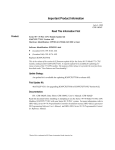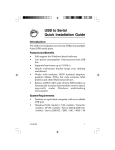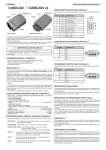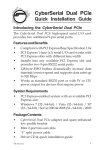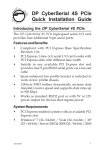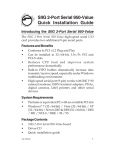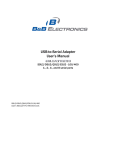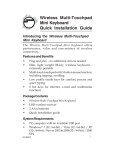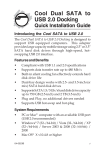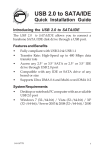Download Siig JU-HS2012-S2
Transcript
USB to Serial Quick Installation Guide Introducing the USB to Serial The USB to Serial adapter converts one USB port to multiple 9-pin (DB9) serial ports. Features and Benefits • • • • • • Full support for Windows-based software Low power consumption. Draws power from USB bus Supports baud rates up to 115 Kb/s Handy wall-mount bracket keeps your desktop uncluttered Works with modems, ISDN terminal adapters, graphics tablets, PDAs, bar code scanners, label printers and other RS232 serial devices Built-in 16550 UART with 16-byte FIFO buffers to dramatically increase data transmit/receive speed, especially under Windows multitasking environment System Requirements • • Pentium or equivalent computer with an available USB port Windows® 7 (32-/64-bit) / Vista (32-/64-bit) / XP (32-/64-bit) / Server 2003 & 2008 (32-/64-bit) / 2000 / ME / 98SE / 98 04-0349C 1 Package Contents • • • • • USB to Serial adapter USB cable Mounting bracket kit Driver CD Quick installation guide Layout Depending on the model purchased your layout will be either the 2-port or 4-port adapter. Power LED USB connector Serial Port Figure 1. 2-port Layout Power LED USB connector Serial Port Figure 2. 4-port Layout 2 Hardware Installation The USB to Serial adapter can be hot-plugged into a USB port of your computer. Important: For Windows 7, Vista and Server 2008 Do Not plug-in the USB to Serial now, install the driver first before plugging the USB to Serial into a USB port. 1. 2. 3. Plug one end of the included USB cable into an available USB port in your computer. Plug the other end of the included USB cable into the back of the USB to Serial adapter. If your computer was on when you plugged in the USB to Serial adapter, go to Driver Installation. Otherwise, turn on the computer now and continue. Driver Installation Windows 7 (32-/64-bit) The driver must first be installed before you plug the USB to Serial into a USB port. If you have plugged-in the adapter prior to installing the driver, unplug it, and then follow the driver installation below. 1. 2. 3. 4. 5. 6. Insert the driver CD and wait for a few seconds. Close the AutoPlay box if prompted. Click the Start button. In the Start Search box, type D:\Vista\install.exe, press Enter. (Change D: to match your CD/DVD-ROM drive letter) At User Account Control, click Allow. At the Welcome screen, click Next. Select I accept the terms of the license agreement, click Next, then click Finish. Plug the USB to Serial adapter into a USB port and the driver will install automatically. 3 Windows Vista (32-/64-bit) The driver must first be installed before you plug the USB to Serial into a USB port. If you have plugged-in the adapter prior to installing the driver, click Cancel at the Found New Hardware window, unplug it, and then follow the driver installation below. 1. 2. 3. 4. 5. 6. Insert the driver CD and wait for a few seconds. Close the AutoPlay box if prompted. Click the Start button. In the Start Search box, type D:\Vista\install.exe, press Enter. (Change D: to match your CD/DVD-ROM drive letter) At User Account Control, click Allow. At the Welcome screen, click Next. Select I accept the terms of the license agreement, click Next, then click Finish. Plug the USB to Serial adapter into a USB port and the driver will install automatically. Windows XP (32-/64-bit) / Server 2003 (32-/64-bit) 1. 2. 3. 4. 5. 6. 4 Plug the USB to Serial into an available USB port. At the Found New Hardware Wizard, select No, not this time, click Next. Insert the driver CD, select Install the software automatically (Recommended), then click Next. Click Continue Anyway, then click Finish. Repeat steps 2-4. For 2S adapter: 1 more time. For 4S adapter: 3 more times. Restart Windows to complete the installation. Windows Server 2008 (32-/64-bit) The driver must first be installed before you plug the USB to Serial into a USB port. If you have plugged-in the adapter prior to installing the driver, click Cancel at the Found New Hardware window, unplug it, and then follow the driver installation below. 1. 2. 3. 4. 5. Insert the driver CD and wait for a few seconds. Click the Start button. In the Start Search box, type D:\Vista\install.exe, press Enter. (Change D: to match your CD/DVD-ROM drive letter) At the Welcome screen, click Next. Select I accept the terms of the license agreement, click Next, then click Finish. Plug the USB to Serial adapter into a USB port and the driver will install automatically. Windows 2000 1. 2. 3. 4. 5. 6. 7. Plug the USB to Serial into an available USB port. At the Found New Hardware Wizard, click Next. Select Search for a suitable driver for my device (recommended) and click Next. Insert the driver CD and wait for a few seconds. Select CD-ROM drives, uncheck the other options, and click Next. Click Next, the click Finish. Restart Windows to complete the installation. 5 To Verify Windows 7 / Vista / XP / Server 2003 & 2008 / 2000 Installation 1. 2. Check Device Manager to verify installation. For Windows 7: Right click Computer, click Manage, then click Device Manager. For Windows Vista: Right click Computer, click Manage, click Continue, then click Device Manager. For Windows XP / Server 2003 / 2000: Right click My Computer, click Manage, then click Device Manager. For Windows Server 2008: Right click Computer, click Manage, double click Diagnostics, then click Device Manager. Click on the + (plus sign) in front of Ports (COM & LPT). For 2S adapter: Prolific USB-to-Serial... or USB-toSerial... should be listed 2 times. For 4S adapter: Prolific USB-to-Serial... or USB-toSerial... should be listed 4 times. Windows ME 1. 2. 3. 4. 5. 6. 6 Insert the driver CD and wait for a few seconds. Plug the USB to Serial into an available USB port. At the Add New Hardware Wizard, choose Automatic search for a better driver (Recommended), then click Next. Select USB-to-Serial, then click OK. Click Finish. Restart Windows to complete the installation. Windows 98SE / 98 1. 2. 3. 4. 5. 6. 7. Plug the USB to Serial into an available USB port. At the Add New Hardware Wizard, click Next. Select Search for the best driver for your device (Recommend), then click Next. Insert the driver CD, select CD-ROM drive, uncheck the other boxes, then click Next. Click Next, then click Finish. Repeat steps 2-5 (skip this step in Windows 98SE). Restart Windows to complete the installation. To Verify Windows ME / 98SE / 98 Installation 1. 2. From the main desktop, right click My Computer, click Properties, then click Device Manager. Double click Ports (COM & LPT). For 2S adapter: USB to Serial... should be listed 2 times. For 4S adapter: USB to Serial... should be listed 4 times. 7 Changing COM Port Number Some serial devices need a specific COM port in order to work. If your serial device works properly, do not change this setting. This option is not available in Windows ME , 98SE and 98. Windows 7 / Vista / XP / Server 2003 & 2008 / 2000 1. 2. 3. 4. 8 From Device Manager double click Ports (COM & LPT), then double click the USB to Serial or Prolific USB to Serial port you want to change. Click Settings tab, then click Advanced. Click the down arrow that is next to the COM Port number box and select a COM port that is not in use. Click OK. Click OK again. Close Device Manager to save the changes. Blank Page 9 Blank Page 10 Technical Support and Warranty QUESTIONS? SIIG’s Online Support has answers! Simply visit our web site at www.siig.com and click Support. Our online support database is updated daily with new drivers and solutions. Answers to your questions could be just a few clicks away. You can also submit questions online and a technical support analysts will promptly respond. SIIG offers a 5-year manufacturer warranty with this product. Please see our web site for more warranty details. If you encounter any problems with this product, please follow the procedures below. A) If it is within the store's return policy period, please return the product to the store where you purchased it. B) If your purchase has passed the store's return policy period, please follow these steps to have the product repaired or replaced. Step 1: Submit your RMA request. Go to www.siig.com, click Support, then RMA to submit a request to SIIG RMA. Your RMA request will be processed, if the product is determined to be defective, an RMA number will be issued. Step 2: After obtaining an RMA number, ship the product. • Properly pack the product for shipping. All software, cable(s) • and any other accessories that came with the original package must be included. Clearly write your RMA number on the top of the returned package. SIIG will refuse to accept any shipping package, and will not be responsible for a product returned without an RMA number posted on the outside of the shipping carton. • You are responsible for the cost of shipping. Ship the product to the following address: SIIG, Inc. 6078 Stewart Avenue Fremont, CA 94538-3152, USA RMA #: • SIIG will ship the repaired or replaced product via Ground in the U.S. and International Economy outside of the U.S. at no cost to the customer. 11 About SIIG, Inc. Founded in 1985, SIIG, Inc. is a leading manufacturer of IT connectivity solutions (including Serial ATA and Ultra ATA Controllers, FireWire, USB, and legacy I/O adapters) that bridge the connection between Desktop/ Notebook systems and external peripherals. SIIG continues to grow by adding A/V and Digital Signage connectivity solutions to our extensive portfolio. All centered around the distribution and switching of A/V signals over CAT5/6, these products include matrix switches, distribution amplifiers, extenders, converters, splitters, cabling, and more. SIIG is the premier one-stop source of upgrades and is committed to providing high quality products while keeping economical and competitive prices. High-quality control standards are evident by one of the lowest defective return rates in the industry. Our products offer comprehensive user manuals, user-friendly features, and most products are backed by a lifetime warranty. SIIG products can be found in many computer retail stores, mail order catalogs, and e-commerce sites in the Americas, as well as through major distributors, system integrators, and VARs. PRODUCT NAME USB to Serial FCC RULES: TESTED TO COMPLY WITH FCC PART 15, CLASS B OPERATING ENVIRONMENT: FOR HOME OR OFFICE USE FCC COMPLIANCE STATEMENT: This device complies with part 15 of the FCC Rules. Operation is subject to the following two conditions: (1) This device may not cause harmful interference, and (2) this device must accept any interference received, including interference that may cause undesired operation. THE PARTY RESPONSIBLE FOR PRODUCT COMPLIANCE SIIG, Inc. 6078 Stewart Avenue Fremont, CA 94538-3152, USA Phone: 510-657-8688 USB to Serial is a trademark of SIIG, Inc. SIIG and the SIIG logo are registered trademarks of SIIG, Inc. SIIG and the SIIG logo are registered trademarks of SIIG, Inc. Microsoft and Windows are registered trademarks of Microsoft Corporation. All other names used in this publication are for identification only and may be trademarks of their respective owners. April, 2010 Copyright © 2010 by SIIG, Inc. All rights reserved.












